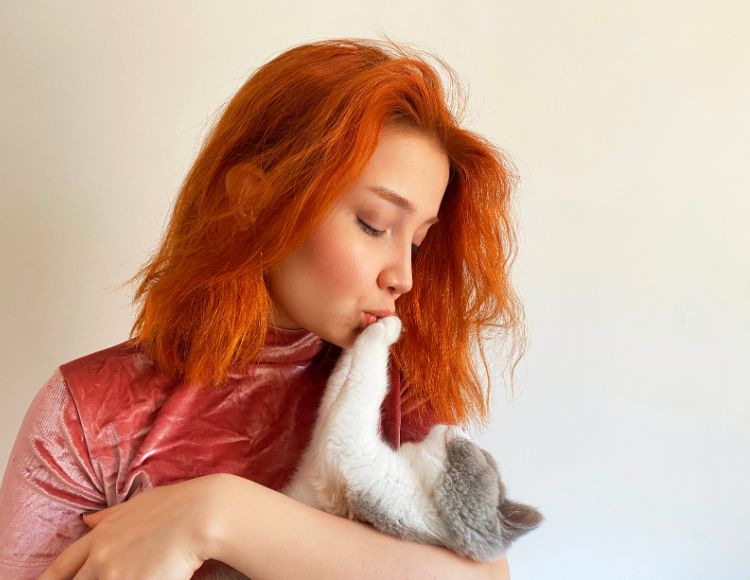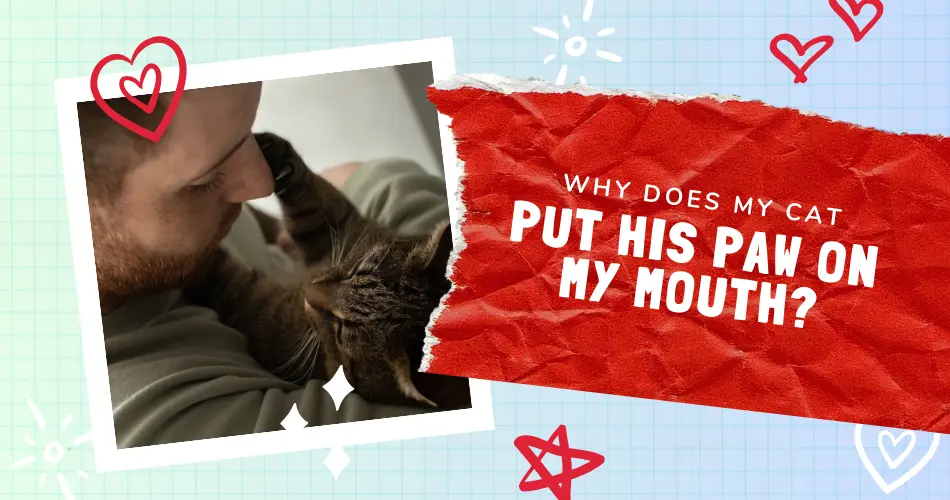Cats usually put their paws on their owners’ mouths to get their attention or communicate with them through physical contact. It is an annoying behavior of cats, but almost every cat sometimes does it.
If you are a cat owner, you may have experienced this behavior at least once. Suppose you are lying in bed, enjoying a peaceful sleep, when suddenly you feel a furry paw on your mouth. You open your eyes and see your cat reaching his paw out to you or your mouth. Why does your cat put his paw in your mouth?
There are many possible reasons cats engage in this behavior, and they are not always negative. In fact, some of them indicate that your cat loves you and trusts you. This article will explain the most common 7 reasons for this cat behavior and how you can respond.
1. Cat Might Find Your Warmth And Breath Soothing
One of the simplest reasons your cat may put his paw on your mouth is that he finds your warmth and breath soothing. Cats always seek out comfort and relaxation sources. When you sleep, your body’s warmth or breathing sound maybe your cat’s comfort source.
Your mouth is a warm area that emits a gentle sound of breathing. It may remind your cat of his mother’s purr or his littermates’ snuggles. By placing his paw in your mouth, your cat may try to recreate that feeling of security and calmness.
If this is the case, you can take it as a compliment that your cat trusts and feels safe with you. You can gently rub your cat’s paw or head to show him you appreciate his affection. If you find this behavior annoying or uncomfortable, you can gently move his paw away or distract him with a toy or a treat.
2. Cats May Mimic The Behavior Of Grooming By Touching Your Face
Cats are very clean animals. They spend a lot of time licking and grooming themselves and their companions. Grooming is a way of showing care, respect, and friendship among cats, and it also helps them bond and maintain their social hierarchy.
When your cat puts his paw on your mouth, he may try to groom you or show you that he considers you part of his family. He may also expect you to groom him back by licking his paw or rubbing your face against his. It is a sign of mutual trust and affection, and you can reciprocate by gently grooming him with your hand or a brush.
However, if you don’t like the idea of your cat touching your mouth, you can politely decline his offer by moving his paw away or giving him a gentle push. You can redirect his attention to another part of your body, such as your hand or arm, and let him groom that instead.
3. To Mark You As Their Territory
Your cat may put his paw on your mouth when trying to mark you as his territory. Cats use various methods to claim their space and resources, such as scratching, rubbing, licking, and biting. By putting his paw in your mouth, your cat may message other cats or animals that you belong to him and that they should stay away from you.
This behavior may indicate that your cat is very possessive and protective of you and values you as his companion. However, it may also indicate that your cat is insecure and anxious and feels threatened by his potential rival pets.
In this case, you can help your cat feel more confident and relaxed by providing him with enough toys, food, water, litter boxes, and hiding places. You should also introduce him to other cats or animals gradually and carefully and avoid sudden changes in his environment or routine.
4. Cats Often Use Physical Contact To Get Your Attention
A more playful reason why your cat may put his paw on your mouth is that he is trying to get your attention. Cats need mental stimulation and interaction to be happy and healthy. Sometimes, they may use physical contact to get you to notice and play with them, especially if they are bored or lonely.
By putting his paw on your mouth, your cat may say, “Hey, wake up! I want to play with you!” or “Hey, look at me! Give me some attention!” It is a sign of your cat’s personality and energy. So, you should respond by giving him some attention and affection.
You can also entertain your cat by playing with his favorite toys or teaching him some tricks or games. But if you are busy or tired, you can ignore his paw or gently push it away, and he will eventually get the hint and leave you alone.
5. Communication Through Body Language
If your cat is expressive, he may try to communicate with you through body language by putting his paw in your mouth. Cats use their eyes, ears, tails, and paws to convey their emotions and intentions. By putting his paw on your mouth, your cat may be telling you something he cannot say with words.
To understand what your cat is trying to say, you must pay attention to his body cues. For example, if your cat puts his paw on your mouth after you scold him for scratching the sofa, he may apologize. He may remind you to feed him if he puts his paw on your mouth before mealtime. During a thunderstorm, he may seek comfort or reassurance if he puts his paw on your mouth. He may express his love and gratitude if he puts his paw on your mouth while purring and cuddling.
By observing your cat’s body language, you can learn to communicate with him better and understand his needs and feelings. You can also respond to his paw gesture by giving him what he wants, comforting him, or reciprocating his affection.
6. Bonding

Your cat may sometimes put his paw on your mouth when trying to bond with you. If your cat is obsessed with you, he wants to form strong attachments. By putting his paw in your mouth, your cat may show you that he trusts and considers you his friend. He may also seek your approval and acceptance or try to make you happy and proud.
This behavior may indicate that your cat has a strong bond with you and enjoys spending time with you. You can strengthen this bond by spending quality time with your cat, such as playing, grooming, talking, or napping with him. You can also reward his paw gesture with praise, treats, or cuddles and show him you appreciate his friendship.
But if you don’t want your cat to continue this behavior, find a different way to bond with your cat. Spend more time with your cat and provide him with enough playing time with you. Also, you can take him outdoors for walks or exercise sessions.
7. Instinctual Behavior
Cats are natural predators that have evolved to hunt, kill, and eat their prey. Sometimes, they may display this behavior with their owners. If your cat is not spayed, neutered, or has a high prey drive, he can put his paw on your mouth.
So, if your cat is putting his paw on your mouth due to instinctual behavior, your cat may be trying to suffocate you, bite your neck, or drag you away, as he would do with a mouse or a bird. This behavior may indicate that he needs more exercise and stimulation.
You can help your cat channel his hunting instincts positively by providing plenty of toys, scratching posts, and interactive games. You can also spay or neuter your cat or consult your vet if he shows signs of aggression or stress.
Summary
As you can see, there are seven possible reasons your cat may put his paw in your mouth. It is an expected and positive behavior of your cat that reflects his love and trust for you. Also, this behavior displays that your cat needs more attention, stimulation, or security.
The best way to find out why your cat does this behavior is to observe his other body cues, context, and personality and respond to him accordingly. Doing so can improve your communication and relationship with your cat, and you can enjoy his company more.

